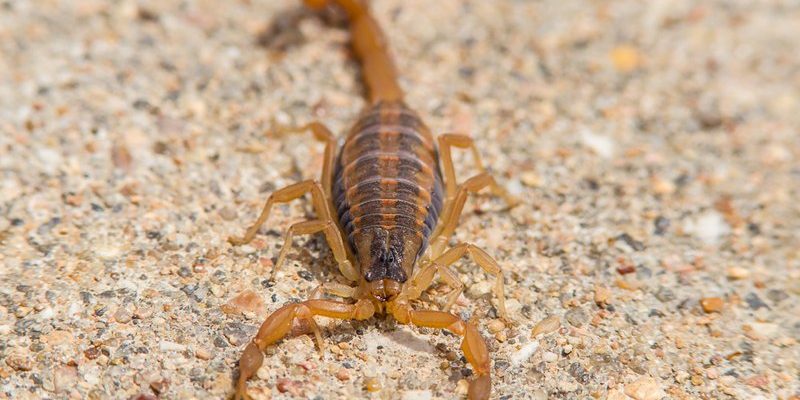
Let’s dive into the world of the striped bark scorpion. This species, scientifically known as *Centruroides vittatus*, has a reputation for being one of the most well-known scorpions in the United States. While they may have a fearsome reputation, understanding where they hang out can help you avoid any unwelcome encounters. So, grab a cup of coffee, and let’s explore the habitats and environments where these little guys thrive!
What Is the Striped Bark Scorpion?
Before we jump into where you can find the striped bark scorpion, let’s talk a bit about what they are. These scorpions are characterized by their distinct yellow-brown coloring with darker stripes running down their backs. Imagine a tiny warrior dressed in brown armor ready to defend its territory. They’re usually around 2 to 4 inches long, which might not sound too intimidating, but their venom can pack a punch.
They’re typically active at night, becoming quite the little night owls of the scorpion world. This nocturnal nature means they often come out when the sun goes down, making them harder to spot during the day. Here’s the thing: while their sting is painful, it’s rarely life-threatening to healthy adults. So, if you do run into one, don’t panic. Just give them their space!
Natural Habitats of the Striped Bark Scorpion
So, where can you find these fascinating creatures in their natural habitats? Striped bark scorpions have a preference for warm, dry environments. Think deserts, rocky areas, and scrubland. They’re like the kids who just love playing outside in the heat. Here are some of their favorite hangouts:
- Rocky Outcrops: They often seek shelter under rocks or in crevices where they can avoid the sun during the day.
- Woodland Areas: Striped bark scorpions can be found in wooded regions, often hiding under leaf litter or beneath fallen logs.
- Urban Environments: Surprisingly, they adapt well to urban areas. You might find them in gardens, parks, or even basements.
These environments not only provide them with shelter but also with ample food. They’re carnivorous, feeding primarily on insects and other small invertebrates they can catch.
Geographical Distribution
The striped bark scorpion is primarily found in the United States, ranging from the eastern to the southwestern regions. They’re particularly common in states like:
- Texas: This state has a warm climate that’s perfect for them.
- New Mexico: Here, they find plenty of places to hide and hunt.
- Arizona: Their numbers are substantial in the desert areas.
- Oklahoma: They thrive in the warmer, drier regions of this state.
Even though they are common in these states, they can also be spotted in parts of California and the Great Plains. Their adaptability allows them to survive in various environments, making them a resilient species.
Behavior and Habitat Preferences
Let’s take a closer look at how striped bark scorpions behave in their habitats. They’re secretive by nature, often hiding in crevices or burrows during the day to escape the heat. You know how some people just love to lounge around indoors during a hot summer day? That’s pretty much how these scorpions roll.
At night, they crawl out to hunt for food. Their preferred diet includes insects like crickets and other small bugs, making them an unexpected ally in gardens while also being a bit of a nuisance when they venture indoors. To them, your living room is just another hunting ground!
Urban Encounters with Striped Bark Scorpions
You might think of scorpions as desert dwellers, but the striped bark scorpion proves otherwise. They’re quite comfortable living in urban settings. Let me explain why this matters. As cities expand, these scorpions adapt to human environments, often finding their way into homes.
Basements and attics are prime spots for them, especially if there are plenty of nooks and crannies. A dark, cluttered basement can feel like a cozy cave to a scorpion. Having a few plants inside also helps because it attracts the insects they feed on. If you live in areas where these scorpions are common, it’s wise to keep your home tidy and sealed to avoid surprises.
Seasonal Movement and Activity
Honestly, the striped bark scorpion has a seasonal routine that many people might not know about. During warmer months, they become more active. Think of them as the life of the party in summer! As temperatures drop in winter, they tend to retreat and become less visible.
In spring and summer, they might crawl out more frequently, especially after rain when the humidity rises. If you’re in an area where they’re common, you might notice them more during these months. That’s when they’re on the hunt!
Tips for Avoiding Striped Bark Scorpions
If you’re concerned about encountering a striped bark scorpion, there are ways to keep yourself safe. Here are some practical tips:
- Keep Your Home Clean: Regularly sweep and declutter areas like basements and garages.
- Seal Cracks: Make sure windows, doors, and foundation cracks are sealed to keep them outside.
- Trim Vegetation: If you have gardens, keep plants trimmed and avoid using too much mulch, which can provide hiding spots.
By taking these precautions, you can minimize your chances of unwanted encounters while still enjoying the beauty of nature in your backyard.
The striped bark scorpion is a fascinating creature that shows us how adaptable life can be. From their rocky homes in the wild to the surprising ways they thrive in urban areas, they remind us that we share our spaces with a wide variety of wildlife.
Understanding where they’re commonly found helps us coexist peacefully. Being informed empowers us to appreciate their role in the ecosystem while keeping ourselves safe. So, whether you’re hiking in the desert or cleaning out your basement, just remember: the striped bark scorpion is more common than you might think. Respect their space, and you’ll both be just fine!

